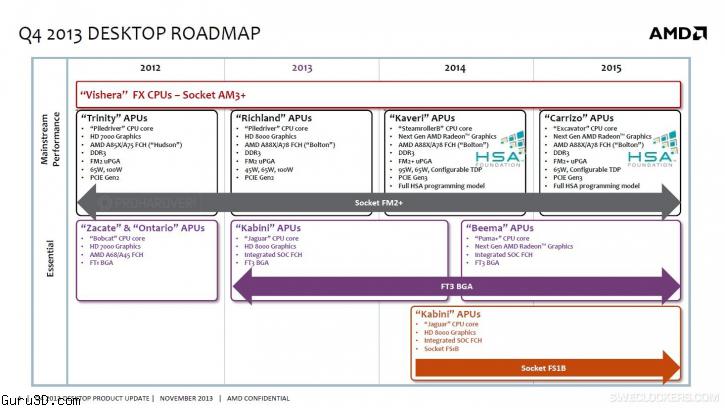Website Gamers Nexus had a chat with AMD Manager of APU/CPU Product Reviews James Prior who states that the FX series processors is not being ended. Earler last week a leaked AMD roadmap suggested that AMD may kill off their high-end processors series. Prior claims he's never seen that slide before and that he doesn't know where it came from.
Prior mentions that the actual AMD roadmap looks different and does not span more than a year into the future, but the official roadmap doesn't really convince us that AMD is still committed to the high-end processor market either.
The roadmap below reveals the 32nm Vishera will stick around throughout 2014 without any significant updates.
--
We recently posted about an alleged slide leak from AMD that, if real, seemed to suggest the end of the line for FX-series CPUs and the AM3+ socket. The slide stirred a great deal of concern throughout major social networks and enthusiast websites, and so I attempted to bring things back down to earth in our original analysis. I reached out to AMD for comment prior to publication, but we weren't able to speak with the company until yesterday. amd-fx AMD Manager of APU/CPU Product Reviews James Prior was quick to negate the slide's legitimacy: "I've never seen that slide before, I don't know where that came from," he told me in our call, and quickly followed-up by stating that "it's not real. FX is not end-of-life." Prior pointed-out that it's rare to ever see more than a year into the future with roadmaps, and that the real AMD roadmap looks like this: amd-desktop-roadmap For a comparison, here's the faked roadmap that led to the speculation about FX's alleged death: amd-leaked-slide-fx The "leaked" roadmap proved to be fake, but gave us a great discussion opportunity. With that out of the way, we dug into the underlying concern: AM3+ has been around for a while. FX has been beaten up a good deal in its lifespan (sometimes fairly, sometimes not so much). With the APU / CPU adoption split around—judging from the Steam hardware survey and other aggregate sources—a 70% / 30% range (respectively), it's easy to see where enthusiast concern would arise, given the progression of APUs and IGP-enabled CPUs in the market. AMD's official statement on the matter of the FX-series as a product line, their current chipsets, and the AM3+ socket is below: "AMD will continue to supply AM3+ and AMD FX processors for the foreseeable future, as per AMD's official roadmap update at APU'13 [above]. Recently, AMD launched the FX-9000 series, AMD's fastest desktop processor to date. As AMD's business continues to evolve, AMD will focus on the areas of growth including support for the desktop PC enthusiast leveraging AMD's world-class processor design IP, including heterogeneous compute. AMD's FX branded products will continue to evolve and we look forward to sharing those updates in the future." To AMD's point, the FX-9370 is easily one of the highest-performing solutions on the market right now, especially considering its present $200 price-point. And on the note of AMD's future updates, let's take this opportunity to discuss the future of game-hardware interactions. Adapting to New Trends: What We Need in a CPU is Changing The objective of this section of the article is to outline the game industry's trends and the hardware industry's facilitation of these trends; we're not telling you that AMD or Intel "do it better," and frankly, there's room for both philosophies in computing. Due to the recent surge in interest in AMD's approach to CPU and APU technology, the below will also present some of our own analysis of their vision. It's well-known that AMD doesn't share the same direction for the future as Intel. Although both companies are pushing for lower TDP (relative to their earlier offerings) and integrated graphics technology, each has differentiating factors. The two manufacturers and their respective architectures are not always linearly comparable, which I think is an easy trap to fall into -- benchmarks and charts only run so deep. Development philosophy plays just as much of a role in functionality as raw performance. Since Bulldozer's unveil 3-4 years ago, AMD has made it clear that it sees future software trending toward heavier multithreading utilization, more integer-intensive applications, and toward greater parallelization of processing.
Bulldozer underscored that AMD doesn't see the same future in x86 architecture as Intel does. These trends have taken shape in the likes of CryEngine 3, which natively supports up to eight simultaneous threads and spawns three threads by default (physics, rendering, game logic); FrostBite 3 works natively to more evenly distribute CPU load across the physical cores presented to it (and doesn't seem to discriminate against CPU manufacturer); and Unreal Engine 4, the newest 'AAA' engine, deploys new system architectures to more efficiently process intense physics / lighting calculations. All three of these engines have put even greater focus on the ability to offload tasks to the GPU. This includes physics calculations, which can be sent to the APU's graphics component while the discrete card handles other tasks (with thanks to Dual Graphics and other AMD tech).
--
AMD says FX is not EOL - but no word on future plans either



